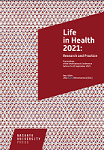Health Promotion by Physical Activity in Relation to Body Composition
Health Promotion by Physical Activity in Relation to Body Composition
Author(s): Tereza Sofková, Michaela Hřivnová
Subject(s): Health and medicine and law, Demography and human biology
Published by: Masarykova univerzita nakladatelství
Keywords: healthy lifestyle; body fat; accelerometer; walking; young adult females;
Summary/Abstract: Regular physical activity is a natural tool in weight control. Appropriate indicators for conclusive evidence of somatic condition are individual body components. Our research objective was to analyse selected body composition fractions in relation to meeting recommended physical activity in young adult females. 258 women participated in our study; women were divided into two groups according to the physical activity level achieved, either meeting or not meeting the recommended physical activity level in terms of intensity (moderate physical activity, 3 to 5.99 MET) and level (≥ 150 min/week). To determine the physical activity parameters, namely the level and intensity within one week and average daily number of steps, ActiGraph GT1M Accelerometer was used. Direct Multi-frequency Bioelectrical Impedance Analysis Method (DSM-BIA Method) using InBody 720 Body Composition Analyser was used to determine body composition parameters. The differences between the groups according to the physical activity level reached were statistically insignificant for the selected body composition fractions we investigated. Lower relative risk of damage to health as measured by the somatic indices (body mass index: BMI, body fat mass index: BFMI) was observed in women carrying out moderate physical activity level (MPA, 3 to 5.99 MET), i.e. 150 to 300 minutes. In the assessment of habitual recommended physical activity level, the women were classified either as active or women with typical daily activities. Research study verified positive relationship between meeting the recommended physical activity level and its impact on health risk indicators, namely lowering body fat mass index (BFMI), lowering body fat (BFP, BFM) and smaller visceral fat area (VFA). Positive approach to the physical activity may lead to the decrease in number of health problems associated with excess weight and obesity in later age.
Book: Life in Health 2021: Research and Practice
- Page Range: 136-147
- Page Count: 12
- Publication Year: 2021
- Language: English
- Content File-PDF

